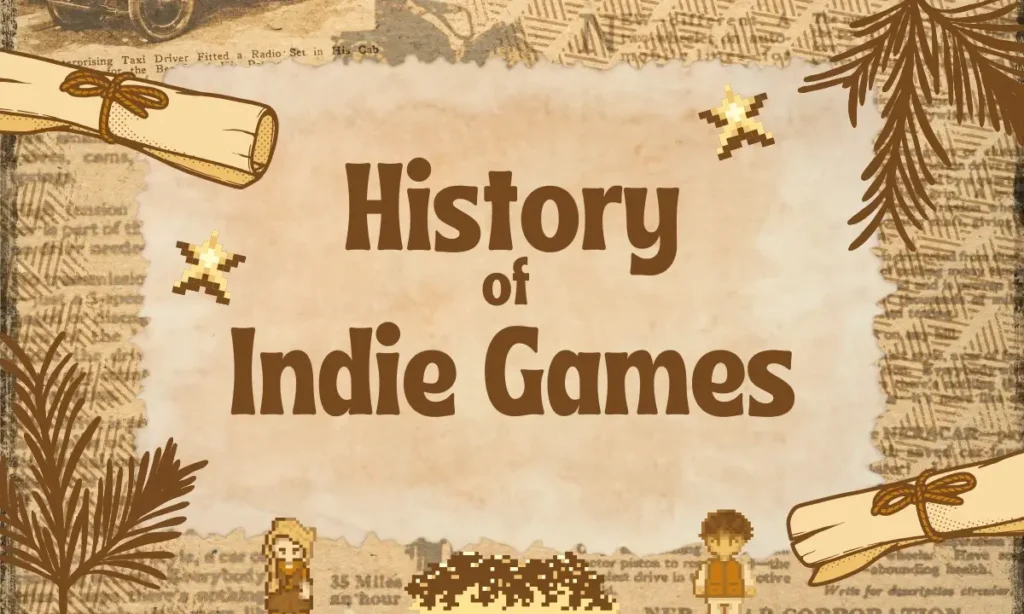The Birth of Indie Games (1970s-1980s)
The history of indie games can be traced back to the 1970s, a time when personal computers were beginning to rise in popularity. Early developers, often hobbyists, found ways to create and share their games without commercial backing. Here’s a breakdown of the key factors that shaped the early indie game scene:
- Early Computers: The Acorn and Commodore systems enabled individuals to create games on their home computers, marking the first wave of independent game development.
- Distribution via Floppy Disks and Tapes: Developers copied games onto floppy disks and cassette tapes, sharing them within small communities. These games were often distributed for free or featured in niche computer magazines.
- Notable Early Games: Titles like Spacewar! (1962) and Zork (1977) were some of the earliest examples of indie-style development, showcasing the DIY ethos of early game creators.
The Rise of the Shareware Model (1980s-1990s)
The 1980s and 1990s marked a critical evolution in indie game distribution with the advent of the shareware model. This model became a gateway for independent developers to reach a broader audience and marked the first step toward bypassing traditional game publishers.
What Is Shareware?
Shareware allowed developers to offer a portion of their game for free, typically the first few levels, encouraging players to purchase the full version if they enjoyed it. This distribution model provided small developers with a low-risk way to get their games in the hands of players without the high costs of physical production and marketing.
Key Developers and Games
- id Software: A prime example of shareware success is Doom (1993), developed by id Software. By distributing the first episode for free, id Software was able to build a massive player base. Doom eventually became a blockbuster, solidifying the shareware model’s place in indie history.
- Apogee Software: Apogee Software, led by Scott Miller, was a pioneer in shareware. The company supported many indie developers by helping them release their games through shareware, notably launching hits like Commander Keen and Duke Nukem.
Why It Worked
Shareware was highly effective in a pre-internet era when games were distributed via floppy disks. Gamers could easily share these disks with friends, further increasing the game’s reach. This model not only democratized game distribution but also fostered a sense of community among indie developers and players.
Challenges and Legacy
By the mid-1990s, as the internet became more widespread, the shareware model began to lose momentum, making way for newer distribution methods like digital downloads. However, the success stories of games like Doom and Commander Keen paved the way for future digital platforms and crowdfunding models that would dominate indie game distribution in the 2000s.
The Rise of Digital Distribution (2000s)
The early 2000s brought a seismic shift in the indie game industry, largely driven by the rise of digital distribution platforms. These platforms provided indie developers with an unprecedented opportunity to bypass traditional retail methods, offering direct access to a global audience. This era marked the beginning of a flourishing indie game scene, where developers could publish their games independently without relying on large publishers.
Key Platforms Revolutionizing Indie Gaming
- Steam (2003): Valve’s Steam platform was one of the most significant developments in digital game distribution. Initially focused on mainstream games, Steam soon opened its doors to indie developers, giving them a powerful tool to distribute their games to millions of users. Early indie successes on Steam, like Braid (2008) and World of Goo (2008), demonstrated the potential of digital storefronts to elevate small developers to mainstream success.
- Xbox Live Arcade (2005): Microsoft’s Xbox Live Arcade also played a crucial role in the indie boom. It provided a curated space for indie titles, helping games like Castle Crashers and Super Meat Boy gain widespread attention.
The Impact of Digital Distribution on Indie Games
Digital distribution made it easier for indie developers to:
- Reach Global Audiences: Platforms like Steam and GOG allowed developers to sell their games worldwide, eliminating the need for physical production and distribution.
- Retain Creative Control: Indie developers could now distribute their games without the need for traditional publishers, which meant they retained full creative control and a larger share of revenue.
- Experiment with New Genres: The absence of publishing constraints led to greater creative freedom, with developers exploring unique storytelling techniques, niche genres, and experimental gameplay.
Notable Indie Game Releases in the 2000s
Some of the most iconic indie games of this period include:
- Braid (2008): Widely considered a groundbreaking indie title, Braid redefined the puzzle-platformer genre with its time-bending mechanics and emotionally resonant story.
- World of Goo (2008): This physics-based puzzle game showed how indie games could rival mainstream titles in terms of innovation and design.
- Minecraft (2009): Perhaps the most successful indie game of all time, Minecraft became a cultural phenomenon, demonstrating that indie games could achieve massive commercial success on a global scale.
Tools Empowering Indie Developers
- Game Engines: The rise of accessible game engines like Unity and Unreal Engine further reduced the barriers to entry for indie developers, allowing them to create high-quality games without needing large teams or studios.
Social Media and Crowdfunding: Platforms like Kickstarter and social media became essential tools for marketing and funding indie games. Developers could build communities around their projects and secure funding directly from their future players.
The Indie Game Explosion (2010-2015)
The period from 2010 to 2015 is often referred to as the Golden Age of Indie Games. This was the time when indie titles began to compete directly with AAA games in terms of both popularity and critical acclaim. Indie games during this period were not only known for their innovative mechanics but also for their ability to tell emotionally resonant stories.
Key Titles That Shaped the Indie Scene
- Super Meat Boy (2010): Developed by Edmund McMillen and Tommy Refenes, Super Meat Boy became an instant success. Released on Xbox Live Arcade (XBLA) and later on Steam, it demonstrated how indie developers could create games with high production value on a small budget. The platformer’s tight controls and challenging levels earned it critical praise and commercial success, proving that indie games could stand toe-to-toe with major releases.
- Braid (2008): Although released slightly earlier, Braid had a lasting impact throughout the 2010s. Developed by Jonathan Blow, the game’s time-bending mechanics and deep narrative were hailed as groundbreaking. Braid also helped popularize digital platforms like XBLA and Steam for indie releases, making it easier for smaller studios to reach broader audiences.
Both of these games were featured in the documentary Indie Game: The Movie (2012), which showcased the personal struggles and triumphs of indie developers. The film helped bring attention to the indie game development process and played a pivotal role in elevating the status of indie games in the public eye.
The Rise of Platforms Supporting Indie Games
- Steam: By 2010, Steam had firmly established itself as the leading platform for indie game distribution. Steam sales and the introduction of the Steam Greenlight program allowed indie developers to get their games in front of millions of users without the backing of major publishers.
- Humble Bundle: This platform, launched in 2010, allowed indie developers to bundle their games and offer them to players on a “pay-what-you-want” model. The success of Humble Bundle helped popularize indie games while giving developers a new avenue for distribution.
Success Stories and Awards
During this period, indie games were not only successful in terms of sales but also began to receive recognition at major gaming award shows. Titles like Fez (2012), Journey (2012), and Hotline Miami (2012) garnered both critical acclaim and commercial success. Journey, in particular, made history as the first indie game to win the prestigious Game of the Year award at the Game Developers Choice Awards. The success of these titles inspired a new generation of developers, further solidifying indie games as a vital and thriving part of the gaming industry.
The “Indiepocalypse” and Market Saturation (2015-2020)
In the mid-2010s, the term “Indiepocalypse” started circulating, reflecting concerns that the explosive growth of indie games had led to market oversaturation. By 2015, platforms like Steam had become flooded with new titles—2,680 games launched on Steam that year alone, a dramatic rise from previous years. The sheer volume of releases made it increasingly difficult for indie developers to stand out, leading to fears that the golden era of indie gaming was coming to an end.
Key Challenges of the Indiepocalypse
- Discoverability Issues: As the number of indie games grew, the challenge for developers was not just making a good game but ensuring it was seen by players. With so many games launching daily, many quality titles struggled to gain visibility. Developers like Daniel West, who created Airscape: The Fall of Gravity, lamented that despite positive reviews, their games were drowned out by the sheer volume of releases.
- Pricing Pressure: The saturation also led to a “race to the bottom” in pricing. Indie developers, in an effort to stand out, began offering steep discounts or participating in bundles like Humble Bundle. While these strategies increased sales temporarily, they also created unrealistic expectations for low prices, which impacted long-term profitability.
- The Role of Marketing: Many indie games began to rely heavily on influencers and YouTubers to get noticed. Games like Crypt of the NecroDancer saw a sales spike after being featured by popular YouTubers. However, developers without these connections often found it difficult to compete.
Responses to the Indiepocalypse
Despite these challenges, some developers and analysts argue that the Indiepocalypse is not the end of indie gaming, but rather an evolution. Indie developers now need to adapt to a more competitive and mature market:
- Focus on Quality: Developers like Noah Cai (Pixel Architect) argue that the higher standards of players today mean that simply releasing a game is no longer enough. Indie games must offer polished experiences and stand out through innovation.
- Diversification: Many indie developers have begun to explore niche markets, offering games that cater to specific genres or communities, ensuring that their titles appeal to dedicated, if smaller, audiences. This approach has allowed titles like Chef RPG to thrive, even in a crowded marketplace.
While the concept of an “Indiepocalypse” sparked genuine concern, it has also led to the maturation of the indie scene. Developers are finding ways to adapt, focusing on quality, building loyal fanbases, and exploring niche genres that larger studios might overlook. The indie game scene, while more competitive, continues to thrive with a diverse range of innovative games.
Indie Game Resurgence and Trends (2020-Present)
The concerns of the Indiepocalypse during the mid-2010s were very real, but by 2020, the indie game scene demonstrated remarkable resilience. Despite market saturation and increasing competition, indie developers have adapted to the challenges by leveraging new technologies, platforms, and community-driven marketing. From 2020 onward, several trends have shaped the continued growth of indie gaming.
The COVID-19 Pandemic and Indie Game Growth
The COVID-19 pandemic, which upended many industries, surprisingly led to a surge in the popularity of indie games. With people stuck at home, video games became a primary source of entertainment. Indie games, which often offered more unique and varied experiences than AAA titles, attracted new players during this period. Platforms like Steam and Itch.io saw a noticeable increase in user engagement and sales.
Some notable indie releases during this period include:
- Hades (2020): Developed by Supergiant Games, Hades became one of the most critically acclaimed games of 2020, winning multiple Game of the Year awards. Its success highlighted the quality and storytelling that indie games could achieve, competing with AAA titles on equal footing.
- Among Us (2018, surge in 2020): Originally released in 2018, Among Us became a global phenomenon during the pandemic. Its simple, social gameplay and accessibility made it a favorite for both casual gamers and streamers alike.
Final Thoughts
The history of indie games is a testament to the creativity, perseverance, and evolution of independent developers over the decades. From the humble beginnings in the 1970s, when hobbyists shared games on floppy disks, to the groundbreaking success stories of the 2000s, indie games have continually shaped the gaming landscape in innovative ways.
The rise of digital distribution in the 2000s, through platforms like Steam and Xbox Live Arcade, allowed indie developers to bypass traditional publishing constraints and reach global audiences. This era produced some of the most iconic indie titles like Braid, Super Meat Boy, and Minecraft, proving that independent developers could rival AAA studios both creatively and commercially.
The challenges of market saturation and the “Indiepocalypse” in the mid-2010s forced developers to adapt by focusing on quality, finding niche audiences, and leveraging community support through crowdfunding platforms.
As indie games continue to thrive, driven by new technologies and an increasingly diverse pool of developers, their influence on the gaming world is undeniable. Indie games not only provide fresh, unique experiences for players but also push the boundaries of what video games can be, ensuring their continued relevance and success in the ever-evolving gaming industry.
FAQs
When did the history of indie games begin?
The history of indie games traces back to the 1970s when hobbyist developers started creating and sharing games on early personal computers like the Acorn and Commodore systems.
What role did the shareware model play in indie game development?
The shareware model, popular in the 1980s and 1990s, allowed developers to distribute a portion of their game for free, encouraging players to purchase the full version. This model helped games like Doom and Commander Keen reach wider audiences without traditional publishers.
How did digital distribution change the indie game scene in the 2000s?
Digital platforms like Steam and Xbox Live Arcade revolutionized indie game distribution by allowing developers to bypass traditional retail, reach global audiences, and retain creative control.
What were some of the key indie games during the 2000s?
Iconic indie games from this era include Braid (2008), World of Goo (2008), and Minecraft (2009), which helped push indie games into mainstream popularity.
What challenges did indie developers face during the “Indiepocalypse”?
In the mid-2010s, the surge in indie game releases led to market saturation, making it harder for developers to stand out. Issues like discoverability and pricing pressures became significant challenges during this time.



